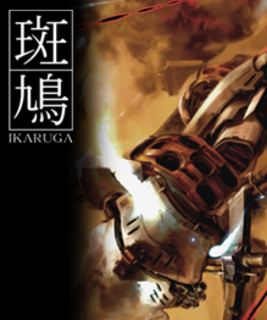Treasure gives us wings, though they’re made of wax.
That’s not to say Ikaruga isn’t easy on the eye. Its repertoire of kaleidoscopic clusters of colour, cohesive enemy design and memorable bosses is an achievement in aesthetics that transcends technical power. Ikaruga’s beauty lies in abstract splendour and coloured lights running riot, and this achieves much greater impact than any deep draw distance ever could.
Not that you’ll have any time to appreciate the distinct looks, save for the tiny breathing space between death and resurrection of your ship. A thunderstorm of adversary awaits you with Ikaruga. It holds such a reputation for its impenetrable difficulty that the triumph of completing it without dying is available on DVD. Frankly shocking expectations on player performance is certainly an acquired taste; initially daunting and exasperating, eventually dangerous and exhilarating.
The game scrolls vertically from intro to credits in around thirty minutes, which is backed by a synchronised musical score that never fails to complement the varied pace and intensity of the game dynamic. Half an hour may sound disheartening in a market where some games boast over 100 hours to see the credits, but Treasure have packed more depth in its five congested levels than, say, Sunshine’s 120 shine sprites ever did.
Initially, Ikaruga demonstrates a tight, precise, linear focus and a basic, intuitive control system to suggest its intention is for a quick blast of kill-or-be-killed. With persistence, this play dynamic adapts to the player’s fluency with the game, evolving and re-evolving into a hi-score game, a puzzle game and - if you’re blessed with surgically precise thumb agility – a performance piece.
The ingenious polarity system, for example, is a finely honed risk/reward structure where set-pieces gradually persuade you to approach with adventurous flair and thrilling daredevil manoeuvres. The very moment you survive a death-defying stunt, you’re hooked on that tremendous feeling of achievement and empowerment, though unsure if you could pull it off next time.
The hi-score system is an addictive, bittersweet addition, where chaining enough hits is awarded with a precious extra life. Of course, this method complicates play enough to guarantee that you’ll loose a life in the process. You’ll hate Ikaruga for the way it dangles bait at every turn, but the prospect of surviving a level with an extra life on board is too tempting to turn down. The glory of an A+ rating is too attractive to resist. The splendour of downing the final boss without spending a continue is not only a personal aspiration, but also an added sub-quest. All the while you’re acting like some frustrated, stupid fish.
That’s the only feeling Ikaruga can guarantee. While fantastic moments resonate from a good performance, not many players will have the time or skill to find it. Ikaruga therefore remains faithful to its arcade-booth heritage in the sense that it still adheres to a pay-to-play scheme, where its greatest moments in play comes with the cost of determined practice and unflappable patience.
[8]
Please Ignore the attributes.

